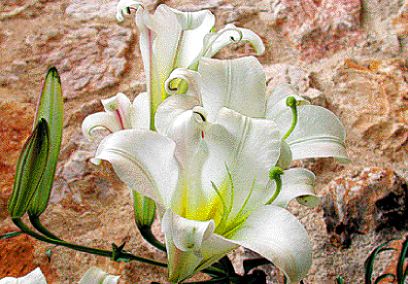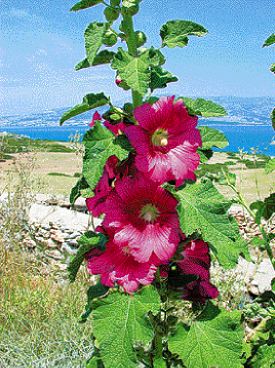 |
||
|
High-Maintenance Beauties
|
||
|
Lilies like good living, with plenty of humus and regular feeding, but they can thrive on balconies provided there is shade and moisture Jennifer Gay |
 |
|
There are about one hundred species of lily and many more hybrids. Their natural habitat is in the woodland and scrub of Europe, Asia and North America. Lily flowers can broadly be divided into four types: trumpet-shaped, bowl-shaped, funnel-shaped and the turkscap, but there are also a few intermediate forms, making them a very varied genus. Whether in a pot or in the garden, preparation of a large space is needed to ensure longevity, encourage the plant to reach its full potential, and build up a bulb for the following year. All lilies like rich living with plenty of humus and regular feeding. Ideally, lilies prefer the treatment of "head in the sun, feet in the shade". This is because their bulbs do not have any protective membrane and so they must never dry out - you need to keep an eye on their moisture levels in winter, but never allow them to get waterlogged or too parched. Full sun under a south-facing wall is simply not an option for lilies in Greece; a well-prepared area within a shrubbery that has sun for half the day is more like the ideal site, or a deep container that is shaded by a low wall of plants. Most bulbs should be planted in autumn. Basal-rooting lilies only produce roots from the bulb, while stem-rooting kinds also produce roots above the bulbs and generally require deeper planting. Basal-rooting bulbs should be planted at a depth of two-three times their height, while stem-rooters should be planted at a depth at least three times their height. They all like well-prepared and well-aerated soil. Humus or a high quality compost should be added to improve nutrient value and soil structure, and a layer of sharp sand should included as a base for the bulbs. It is helpful to pour sand in and around the bulbs to fill all the gaps left between the scales. Some lilies are said to require an acidic growing medium, but most simply need humus and moisture to thrive; failure that is attributed to incorrect pH values is more likely due to poor soil structure. Lilies that are not lime-tolerant can be planted in ericaceous (Azalea or Rhododendron) compost to which lime-free grit has been added to aid drainage, and then given appropriate liquid feed during the growing season. Lilies respond amazingly well if given fortnightly applications of the high-potash liquid fertilizers used to feed tomatoes during their active growth. |
||
Best picks Lilium candidum, the Madonna Lily (Pathenikos Krinos, Krinos tis Panayias) has been cultivated for centuries, representing purity in the language of flowers. After all those years, it still holds its own as a very beautiful ornamental. In early to mid summer, stems up to 1.5 metres tall bear numerous trumpets of satin white petals with golden anthers and delicious fragrance. It is a basal-rooting lily, and tolerating drier soil than other lilies it does best with quite shallow planting in a warm, sheltered spot. The Madonna Lily has naturalised in various parts of the European Mediterranean, including west and south Greece according to some authorities but it is not commonly seen. |
 |
|
The familiar and much loved Lilium regale, the Regal Lily is one of the easiest lilies to grow, and one of the most splendid, fully living up to its name. Stems 1.2-1.8 metres high carry clusters of ivory white trumpets, flushed with pink producing great wafts of scent. The Regal Lily is a stem-rooter and so requires deeper planting. It is easy to bring on from seed. Among the most vivid of the lily hybrids are those of orange colouring. One of the most vigorous and strongly coloured is 'Enchantment' (pictured above R). Blooming in early summer, the fiery orange bowl-shaped flowers are clustered at the end of stems 90cm high - it is a good cutting flower. The Common Turk's Cap Lily (Lilium martagon) makes a far more modest but no less interesting offering of reddish-purple and plum coloured flowers, some darkly spotted with curved back petals (hence Turk's cap) all elegantly just hanging off the stem. It does better in shade on an alkaline soil, and being a stem-rooting bulb requires deeper planting. Repot lilies annually (or biennially) in autumn or early spring, adding compost and slow-release fertiliser. One unfortunate drawback with lilies is their susceptibility to viruses transmitted by aphids which eventually so distorts the foliage that removal and burning is the only option. The best solution is to grow stock from seed, which means the new plants are free of infection at the start of their life. In order to minimise infection always buy clean undamaged bulbs that are fresh looking, avoiding those desiccated specimens stored in bags of wood shavings that are sometimes offered for sale. Lilium lancifolium and some of its hybrids are carriers of viral disease but show no symptoms, so keep them away from other lilies to minimise infection. Infected plants should be sprayed with an insecticidal soap or soapy water two or three times a week. Grey mould (botrytis) may cause problems in damp, windless conditions. Clear away dead and dying plant material and make sure there is good air circulation by ensuring plants are adequately spaced. Poorly drained positions may encourage basal rot. Red lily beetle may also prove a problem, eating through foliage and flowers from early spring to mid autumn. Look out for the bright red adults about 8mm long - they can be picked off by hand or chemical users can spray with bifenthrin. |
||
* Further reading: Lilies: A guide to choosing and growing lilies by Jefferson Brown and Andrew Lawson. 2003, Quadrille Publishing |
||
|
Flowering now HOLLYHOCKS (Alcea rosea) are nostalgic favourites and just about everybody recognises them even if they don't know their name. At up to 2.5 metres, the slender stems peep over the top of walls, or provide great height and colour at the back of a mixed border. Butterflies and bees love them. The five-petalled flowers, often doubles in cultivars, sit flat on the stem; the "original" Hollyhock from W Asia is pink, but the cultivars come in a range of colours including apricot, red, white, lavender-blue, yellow and purple. It has virtually naturalised in some areas of Greece, growing in rocky areas and dry, grassy wasteland. |
 |
|
|
Gardeners' queries |
||
(Posting Date 8 July 2006) HCS readers can view other excellent articles by this writer in the News & Issues and other sections of our extensive, permanent archives at the URL http://www.helleniccomserve.com./contents.html
All articles of Athens News appearing on HCS have been reprinted with permission. |
||
|
||
|
2000 © Hellenic Communication Service, L.L.C. All Rights Reserved. http://www.HellenicComServe.com |
||

